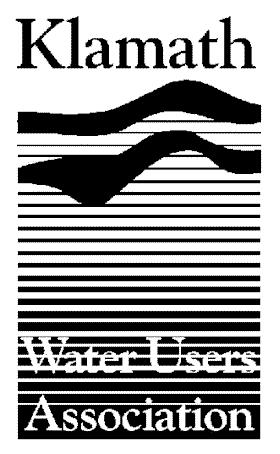|
FACT SHEET
Local Efforts to Assist National Wildlife Refuges
- Voluntary, Early Shutdowns of Tulelake Irrigation District in 1992,
1994 and 2000 to provide more water for environmental purposes.
- Ag interests helped secure $3 million in 1997 to provide refuge water
supplies.
- Development of Integrated Pest Management Plan.
- Development of guidelines to manage refuge water.
KWUA Ecosystem Enhancement and Sucker Recovery Efforts
- KWUA Sprague River riparian improvements: 14 miles of riparian fencing
and other improvements implemented at a cost of $250,000.
- KWUA Biological assessments of grazing allotments in Modoc National
Forest.
- Development in 1993 and 2001 of two ecosystem-based, scientifically
valid planning documents on Klamath Basin restoration.
Fish Passage Improvement Projects
- Screening the main diversion at the "A" Canal: approx. $12 million
(funded by USBR)
- Chiloquin Dam Fish Passage Improvement: feasibility study underway,
KWUA and other landowners participating in a collaborative study process.
- Oregon Department of Fish and Wildlife Fish Passage Improvements: 13
projects completed for $250,000; 40 more are planned at a cost of $1.3
million.
- Other Project Entrainment Reduction Efforts: KWUA and local water
districts participate in technical committee to develop multi-year
implementation plan.
Wildlife Enhancement and Wetland Restoration Efforts
- Farmland to Wetland Conversions: Over 24,000 acres in the past 10
years.
- Klamath Basin Ecosystem Restoration Office Coordination with
Landowners: 271 projects implemented by U.S. Fish and Wildlife Service at
a cost of over $10.5 million between 1994-2001. Over 100 of these
projects, costing over $5.2 million, included private landowners as
partners.
- Partnership-Driven Conservation Efforts Undertaken by the U.S.
Department of Agriculture and Local Conservation Districts: 13,781 acres
of Oregon farmland managed for wildlife habitat purposes since 1999. In
California, 1,700 acres enrolled in Wetland Reserve Program near Tulelake
and Butte Valley since 2000. Nearly 550 acres of farmland in this area
have been enrolled in the Conservation Reserve Program since 1985.
- Oregon Department of Fish and Wildlife Partnership Projects: Since
1995, 40 projects have been completed at a cost of $346,000.
- Other watershed management efforts are underway through forums like
the Oregon Watershed Enhancement Board, the U.S. Forest Service,
California Waterfowl Association, and other state, federal and private
interests.
- Projects Completed by Voluntary Local Interests: Numerous conservation
and restoration projects have been initiated by local landowners and
funded at their own expense.
Local Efforts to Improve Water Quality
- Oregon SB 1010 Implementation: Local advisory committees are currently
reviewing plans developed for the Lost River and Klamath Headwaters
watersheds.
- Upper Klamath Lake Pilot Oxygenation Study: KWUA proposed this study
as part of a comprehensive plan to preserve multiple beneficial uses of
Upper Klamath Lake.
- Klamath Irrigation District (KID)– NPDES Permit: KID in July 2002
secured the first-of-its kind water quality permit from Oregon DEQ. The
permit allows the district to apply aquatic herbicides to control weed
growth under guidelines that protect the environment.
- Klamath County Stormwater Quality Management Efforts: The County has
completed actions aimed at improving erosion and sediment control,
implementing stormwater "best management practices", and assessing
"illicit" discharge connections.
Power Resource Development
- In 2003, roughly 20% of KWUA’s budget will be dedicated to moving
forward with developing a strategic plan to address looming power
challenges.
Efforts to Improve Klamath Project Water Supply Reliability
- Local water users and other stakeholders spent considerable time and
expense engaging in the Klamath Project Operations Plan process.
- 1999-2001 Efforts to Develop a Demand Reduction Program: Local water
users spent time and money to develop a demand reduction program that was
rejected by USBR in 2001. Reclamation’s program compensated 148 landowners
for not farming, before Upper Klamath Lake water supplies were curtailed
months later.
- 2002 Environmental Water Bank: KWUA and local producers have spent
hundreds of hours developing a dry-year water bank intended to compensate
farmers for changing management practices that leave more water for
environmental purposes.
Efforts to Improve Water Use Efficiency
- Despite the fact that the Klamath Project is one of the most water-use
efficient reclamation projects in the country, water users have
demonstrated their willingness to participate in actions that might
further stretch tight water supplies.
- Over 500 growers have applied for 2002 Farm Bill funding to help
cost-share projects that conserve water. All applicants are required to
develop conservation plans for their property.
- In addition to several local irrigation districts pursuing long-term
water conservation plans and individual projects, proactive conservation
and groundwater substitution measures undertaken by water users in 2002
allowed over 30,000 acre-feet of water to be released from the Project to
meet two, separate, and unexpected downstream tribal trust calls.
|
